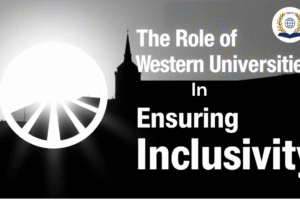
The Digital Divide and the Future of Education: Bridging the Gap for a More Equitable World
As technology continues to revolutionize education, the digital divide remains one of the greatest barriers to achieving global educational equity. While online education has the potential to democratize learning, millions of students worldwide still struggle to access digital resources due to limited internet infrastructure, high costs, and lack of digital literacy. To ensure that online education fulfills its promise as a great equalizer, institutions, policymakers, and tech innovators must work together to bridge the digital divide.
This blog explores the ongoing challenges of digital accessibility, emerging technologies that can enhance educational inclusion, and the role of policy reforms in shaping a more equitable future for learners worldwide.
The Digital Divide: Understanding the Challenge
The digital divide refers to the gap between those who have access to modern digital technology and those who do not. This gap is most evident in low-income communities and rural areas, where reliable internet access and affordable devices remain scarce.
- Infrastructure Gaps – Many developing regions lack the broadband networks necessary to support online education, leading to inconsistent access and slower learning progress.
- Cost Barriers – Internet services, digital devices, and e-learning tools remain prohibitively expensive for many students in underserved communities.
- Digital Literacy Disparities – Even when technology is available, students and educators often lack the skills needed to fully engage with digital learning platforms.
These barriers reinforce existing socio-economic inequalities and limit the potential of online education to uplift marginalized communities.
Innovative Solutions to Bridge the Digital Divide
Despite these challenges, innovative approaches are emerging to make online education more accessible and inclusive.
1. Low-Bandwidth Learning Platforms
Many online education providers are developing low-bandwidth or offline learning solutions to accommodate students with limited internet access.
- Example: Kolibri – A free offline learning platform that allows users to download educational content and use it without an active internet connection.
- Example: M-Shule – A mobile-based SMS learning tool in Kenya that delivers lessons via text messages, making education accessible even without smartphones or high-speed internet.
2. Government-Led Initiatives for Digital Inclusion
Several governments are prioritizing digital inclusion through large-scale initiatives that aim to improve internet access and digital literacy.
- Example: India’s Digital India Initiative – Focuses on expanding broadband access in rural areas and providing free digital learning resources.
- Example: Brazil’s Connectivity Program – Implements policies to ensure free or subsidized internet access for students in low-income households.
3. Tech-Driven Accessibility Innovations
Advancements in educational technology are helping to create a more inclusive learning environment for students facing physical and cognitive challenges.
- AI-Powered Adaptive Learning: Platforms like Coursera and Khan Academy use AI to personalize lesson plans based on a student’s strengths and weaknesses.
- Assistive Technologies: Screen readers, voice commands, and transcription tools make online education accessible to learners with disabilities.
- Virtual Reality (VR) and Augmented Reality (AR): These immersive technologies offer hands-on learning experiences for students in fields like science, medicine, and engineering, regardless of their location.
4. Public-Private Partnerships to Reduce Costs
Collaboration between governments, educational institutions, and tech companies can help reduce the financial burden of online education by subsidizing internet access, providing free learning tools, and distributing affordable devices.
- Example: Google’s Internet for All Initiative – Works with policymakers to bring free or low-cost internet access to underserved regions.
The Role of Policy in Closing the Digital Divide
While technology and innovation are critical to expanding digital education, policy reforms are essential in ensuring long-term accessibility.
- Investments in Digital Infrastructure – Governments must prioritize the development of broadband networks and electricity grids to support digital learning.
- Affordable Internet Policies – Lowering the cost of internet services and providing subsidies for students can increase participation in online education.
- Integration of Digital Literacy in School Curricula – Teaching digital skills at an early age ensures that students can navigate and benefit from online learning platforms.
- Global Collaboration for Digital Education – International organizations and governments must work together to establish standards and best practices for digital inclusion.
Conclusion: The Future of Digital Education
Bridging the digital divide is not just about improving education—it is about fostering economic growth, innovation, and social mobility on a global scale. Online education has the potential to reshape the future of learning, but only if accessibility is prioritized through strategic investments, innovative technologies, and inclusive policies.
To create a world where education is truly a universal right, institutions, governments, and tech leaders must continue working toward breaking digital barriers and making knowledge accessible to all.
Call to Action
At ISBSS, we believe that education should have no boundaries. Join our global online learning community and gain access to flexible, high-quality courses designed to empower you in today’s digital economy. Start your journey today.



